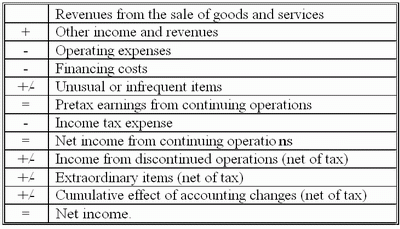Subject 2. Major Financial Statements
#analyst-notes #cfa-level-1 #fra-introduction #has-images #reading-22-financial-statement-analysis-intro #study-session-7
Financial statements are the most important outcome of the accounting system. They communicate financial information gathered and processed in the company's accounting system to parties outside the business.

Assets = Liabilities + Stockholders' Equity
The four principal financial statements are:
- Income statement (statement of earnings)
- Balance sheet (statement of financial position)
- Cash flow statement
- Statement of changes in owners' or stockholders' equity
These four financial statements, augmented by footnotes and supplementary data, are interrelated. In addition, there are other sources of financial information, such as management discussion and analysis, auditor's reports, etc.
Income Statement
The income statement summarizes revenues earned and expenses incurred, and thus measures the success of business operations for a given period of time. It explains some but not all of the changes in the assets, liabilities, and equity of the company between two consecutive balance sheet dates.
The income statement lists income and expenses as they are directly related to the company's recurring income. The format of the income statement is not specified by U.S. GAAP and actual format varies across companies. The following is a generic sample:

The goal of income statement analysis is to derive an effective measure of future earnings and cash flows. Analysts need data with predictive ability, hence income from continuing (recurring) operations is considered to be the best indicator of future earnings. As operating expenses do not include financing costs such as interest expenses, operating income (EBIT) is independent of the company's capital structure.
In the typical income statement this means segregating the results of normal, recurring operations from the effects of nonrecurring or extraordinary items to improve the forecasting of future earnings and cash flows. The idea here is that recurring income is persistent. If an item in the unusual or infrequent component of income from continuing operations is deemed not to be persistent, then recurring (pre-tax) income from continuing operations should be adjusted.
The net income figure is used to prepare the statement of retained earnings.
Balance Sheet
A balance sheet provides a "snapshot" of a company's financial condition. Think of the balance sheet as a photo of the business at a specific point in time. It reports major classes and amounts of assets, liabilities, stockholders' equity, and their interrelationships as of a specific date.
- Assets are the economic resources controlled by the company.
- Liabilities are the financial obligations that the company must fulfill in the future. Liabilities are typically fulfilled by payment of cash. They represent the source of financing provided to the company by the creditors.
- Equity ownership is the owner's investments and the total earnings retained from the commencement of the company. Equity represents the source of financing provided to the company by the owners.
Cash Flow Statement
The primary purpose of the cash flow statement is to provide information about a company's cash receipts and cash payments during a period. It reports the cash receipts and cash outflows classified according to operating, investment, and financing activities.
The cash flow statement is useful because it provides answers to the following simple yet important questions:
- Where did the cash come from during the period?
- What was the cash used for during the period?
- What was the change in the cash balance during the period?
The statement's value is that it helps users evaluate liquidity, solvency, and financial flexibility.
- Liquidity refers to the "nearness to cash" of assets and liabilities, or having enough cash available to pay debts when they are due.
- Solvency refers to the company's ability to pay its debts as they mature. Cash flows reflect the company's liquidity and long-term solvency.
- Financial flexibility refers to a company's ability to respond and adapt to financial adversity and unexpected needs and opportunities. For example, cash flow information can be used to evaluate the effects of major investment and financing decisions.
The details of income statements, balance sheets and cash flow statements will be covered in Study Session 8.
Statement of Changes in Owners' Equity
This statement reports the amounts and sources of changes in equity from capital transactions with owners. It reports ownership interests in order of preference upon liquidation and dividends. For example, the first item listed gets paid off first after creditors in the event of liquidation.
Discussion
Do you want to join discussion? Click here to log in or create user.